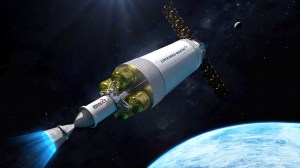NRO expects to launch first spy satellites for proliferated constellation in May

COLORADO SPRINGS, Colo. — The National Reconnaissance Office is targeting early May to begin launching the first phase of an operational proliferated constellation of spy satellites to enhance the military’s ability to gather space-based intelligence.
The mission, dubbed NROL 146, will be the first launch of six that are planned in 2024 for the NRO’s future proliferated architecture, Troy Meink, the agency’s principal deputy director, said Tuesday during a keynote speech at the annual Space Symposium in Colorado Springs, Colorado. Additional launches are expected to fill out the constellation through 2028.
“This launch will be the first launch of an actual operational system,” Meink said. “This system will increase timeliness of access, diversity of communication paths and enhance our resilience.”
NROL-146 will be launched from Vandenberg Space Force Base in California. Meink did not provide details about how many payloads would be included in the first launch in May, or how many satellites NRO wants for the proliferated constellation.
Like elsewhere in the space sector, the agency in recent years has begun shifting its focus away from only stationing a small number of large, expensive intelligence-gathering satellites in high orbital regimes and instead launching hundreds of smaller systems into low-Earth orbit.
During last year’s Space Symposium, NRO Director Chris Scolese said that the office expected to quadruple the number of satellites it has in orbit.
“These satellites — large and small, in multiple orbits — will deliver an order of magnitude more signals and images than we’re getting now, and will be composed of a mix of government and commercial systems,” Scolese said at the time.
Despite precedence from government organizations like the Space Development Agency and the commercial sector, NRO has already launched a couple of demonstration satellites in order to verify cost and performance before fielding operational payloads, Meink said.
The ability to move forward with a proliferated architecture was enabled by some key advancements in technology and acquisition. The cost of launching satellites has decreased dramatically in recent years — a trend that is expected to continue with the Space Force’s National Security Space Launch (NSSL) Phase 3, he noted.
Under the program, the Space Force plans to contract with commercial launch providers beginning in fiscal 2025 for missions starting in fiscal 2027. The service intends to select three vendors to compete for individual launch contracts, as opposed to just two as in previous launch phases.
Meink noted that access to more locations and innovations in reusable rocket boosters have contributed to reduced launch costs, as well.
“These variations and launch opportunities help us both from a cost perspective, but they also give us a lot of flexibility,” he said. “The significant decline and a cost to entry for launch has not only opened the market for new commercial space, … but it’s made new architecture approaches possible for us.”
In addition, innovations in digital technology from the commercial sector have enabled NRO to explore new architectures and capabilities — something that the office is taking full advantage of, Meink said.
Lastly, a proliferated architecture with hundreds of low-cost systems allows the NRO to take more risk and move more quickly through the acquisition process, he added.
“If we’re building a couple of really expensive satellites and we’re only launching them every year or two, you have to take a very low risk posture,” Meink said. “If you’re building a lot of satellites and you’re launching multiple per year, you have much more flexibility in how you take satellite risk while still guaranteeing low risk of the overall constellation.”






